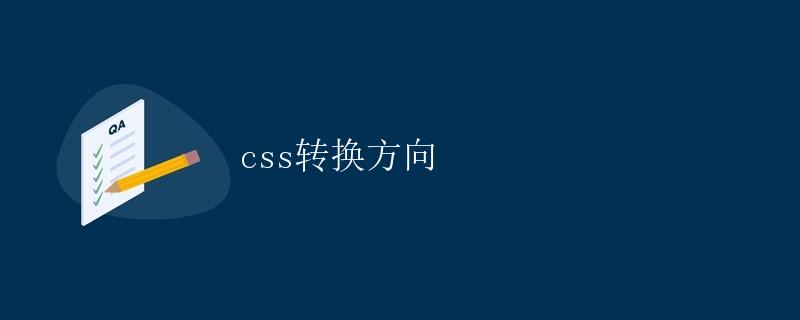CSS 转换方向

在网页设计中,经常会遇到需要改变文本或元素的方向的情况。CSS提供了多种方式来实现文本或元素的方向转换,包括文本方向、布局方向等。本文将详细介绍CSS中如何实现文本或元素的方向转换。
1. 文本方向
1.1 文本方向属性
在CSS中,可以使用direction属性来控制文本的方向,有两个可选值:ltr(从左到右)和rtl(从右到左)。
示例代码:
.text-ltr {
direction: ltr;
}
.text-rtl {
direction: rtl;
}
1.2 文本方向示例
<!DOCTYPE html>
<html lang="en">
<head>
<meta charset="UTF-8">
<meta http-equiv="X-UA-Compatible" content="IE=edge">
<meta name="viewport" content="width=device-width, initial-scale=1.0">
<title>Text Direction Example</title>
<link rel="stylesheet" href="styles.css">
</head>
<body>
<div class="text-ltr">Hello, sotoolbox.com</div>
<div class="text-rtl">مرحبا، sotoolbox.com</div>
</body>
</html>
代码运行结果:

2. 布局方向
2.1 弹性盒子布局
在CSS中,可以使用弹性盒子布局(Flexbox)来控制元素的排列方向。通过设置flex-direction属性,可以指定元素的主轴方向。
示例代码:
.flex-container {
display: flex;
flex-direction: row; /* 水平排列 */
}
.flex-container-column {
display: flex;
flex-direction: column; /* 垂直排列 */
}
2.2 弹性盒子布局示例
<!DOCTYPE html>
<html lang="en">
<head>
<meta charset="UTF-8">
<meta http-equiv="X-UA-Compatible" content="IE=edge">
<meta name="viewport" content="width=device-width, initial-scale=1.0">
<title>Flexbox Layout Example</title>
<link rel="stylesheet" href="styles.css">
</head>
<body>
<div class="flex-container">
<div>Item 1</div>
<div>Item 2</div>
<div>Item 3</div>
</div>
<div class="flex-container-column">
<div>Item 1</div>
<div>Item 2</div>
<div>Item 3</div>
</div>
</body>
</html>
代码运行结果:

2.3 网格布局
除了弹性盒子布局,CSS还提供了网格布局(Grid)来实现元素的排列。通过设置grid-template-columns和grid-template-rows属性,可以控制元素的布局方向。
示例代码:
.grid-container {
display: grid;
grid-template-columns: 100px 100px 100px;
grid-template-rows: 50px 50px;
}
2.4 网格布局示例
<!DOCTYPE html>
<html lang="en">
<head>
<meta charset="UTF-8">
<meta http-equiv="X-UA-Compatible" content="IE=edge">
<meta name="viewport" content="width=device-width, initial-scale=1.0">
<title>Grid Layout Example</title>
<link rel="stylesheet" href="styles.css">
</head>
<body>
<div class="grid-container">
<div>Item 1</div>
<div>Item 2</div>
<div>Item 3</div>
<div>Item 4</div>
<div>Item 5</div>
<div>Item 6</div>
</div>
</body>
</html>
代码运行结果:

3. 其他方向转换
3.1 旋转元素
通过CSS的transform属性,可以实现元素的旋转效果。可以使用rotate函数来指定旋转角度。
示例代码:
.rotate {
transform: rotate(45deg);
}
3.2 旋转元素示例
<!DOCTYPE html>
<html lang="en">
<head>
<meta charset="UTF-8">
<meta http-equiv="X-UA-Compatible" content="IE=edge">
<meta name="viewport" content="width=device-width, initial-scale=1.0">
<title>Rotate Element Example</title>
<link rel="stylesheet" href="styles.css">
</head>
<body>
<div class="rotate">Hello, sotoolbox.com</div>
</body>
</html>
代码运行结果:

3.3 翻转元素
除了旋转,还可以使用CSS的transform属性来实现元素的翻转效果。可以使用scaleX和scaleY函数来实现水平和垂直翻转。
示例代码:
.flip-horizontal {
transform: scaleX(-1);
}
.flip-vertical {
transform: scaleY(-1);
}
3.4 翻转元素示例
<!DOCTYPE html>
<html lang="en">
<head>
<meta charset="UTF-8">
<meta http-equiv="X-UA-Compatible" content="IE=edge">
<meta name="viewport" content="width=device-width, initial-scale=1.0">
<title>Flip Element Example</title>
<link rel="stylesheet" href="styles.css">
</head>
<body>
<div class="flip-horizontal">Hello, sotoolbox.com</div>
<div class="flip-vertical">Hello, sotoolbox.com</div>
</body>
</html>
代码运行结果:

结语
通过本文的介绍,我们了解了在CSS中如何实现文本或元素的方向转换。无论是控制文本方向、布局方向,还是实现元素的旋转、翻转效果,都可以通过CSS轻松实现。
此处评论已关闭